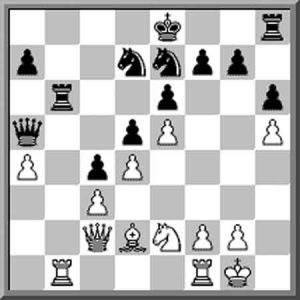FIDE Candidates Tournament
Yekaterinburg, Russia
March 15–April 5, 2020
Current Standings (round 7 of 14)
1–2 Maxime Vachier-Lagrave FRA 2767, Ian Nepomniachtchi RUS 2774, 4.5/7
3–6 Fabiano Caruana USA 2842, Alexander Grischuk RUS 2777, Anish Giri NED 2763, Wang Hao CHN 2762, 3.5/7
7–8 Kirill Alekseenko RUS 2698, Ding Liren CHN 2805, 2.5/7
Average Rating 2774 — Category 21
Time Control: 100 minutes for the first 40 moves, then 50 minutes for the next 20 moves, then 15 minutes for the rest of the game with 30 seconds added to the clocks after every move starting move 1
Special Rules: No draw offers allowed until after move 40
Tie Breaks: The following are used to break a tie for 1st place: (1) Direct encounter, (2) Wins, (3) Sonneborn-Berger. If they are still tied after the three systems are applied then a playoff beginning with four 25-minute games is played
Maxime Vachier-Lagrave defeated erstwhile tournament leader Ian Nepomniachtchi in the 7th round of the Candidates Tournament and tied with him for the lead.
Opening Note: In December 2017 Demis Hassabis (a former world-ranked junior chess player) and his DeepMind team (DeepMind is a subsidiary of Google Inc.) introduced AlphaZero to the world. It is an artificial intelligence which can play chess. What is so revolutionary about it is that whereas the usual chess engines (the big 3 of which is Stockfish, Komodochess and Houdini) are taught by their programmers and GM consultants on how to play chess AlphaZero had a different approach. Through the process of machine learning it is just given the rules of the game and by playing against itself the algorithm determines the moves which are more likely to give you a win. As it plays more and more games it naturally gets better and better. This is the so-called Monte Carlo method.
AlphaZero was matched against Stockfish 8, the acknowledged computer chess champion, in a series of twelve 100-game matches and the Monte Carlos engine won 290, drew 886 and lost 24.
This new artificial intelligence chess engine really played some awesome games and naturally the openings it played (which, I emphasize, were not fed into it by humans but which it developed itself) were put under great scrutiny.
Many articles and even books (especially the one written by GM Matthew Sadler and Natasha Regan entitled Game Changer is very good) have been written about its “groundbreaking chess strategies.” One of its favorite maneuvers is to push its h-pawn towards the opponent’s kingside castled king. If it is not blocked it will continue its march as far as h6. This of course goes against the long-held classical strategy of not advancing one’s flank pawns but the results speak for themselves.
Many GMs are now adopting this strategy. For example in the Gruenfeld Exchange we have lately been seeing 1.d4 Nf6 2.c4 g6 3.Nc3 d5 4. cxd5 Nxd5 5.e4 Nxc3 6.bxc3 Bg7 7.Bc4 c5 8.Ne2 O-O 9.O-O Nc6 10.Be3 b6 11.h4 and sometimes without waiting to castle first himself: 1.d4 Nf6 2.c4 g6 3.Nc3 d5 4.cxd5 Nxd5 5.e4 Nxc3 6.bxc3 Bg7 7.Bc4 c5 8.Ne2 O-O 9.Be3 Nc6 10.h4.
That is the historical background to the following game we are about to see.
Vachier Lagrave, Maxime (2767) — Nepomniachtchi, Ian (2774) [C18]
FIDE Candidates 2020
Yekaterinburg (7.2), 25.03.2020
1.e4 e6 2.d4 d5 3.Nc3 Bb4 4.e5 c5 5.a3 Bxc3+ 6.bxc3 Ne7 7.h4
We have entered the realm of the French Winawer Variation, and the main line starts with 7.Qg4 leading to a very sharp struggle. Lately, with all this AlphaZero groundbreaking strategies stuff the text move has become very popular. There was a series of articles many years ago in Inside Chess by Yasser Seirawan trying to show that the Winawer has been refuted. Bobby Fischer agrees with him — many years earlier he had said that “I may be forced to admit the Winawer is sound. But I doubt it! The defense is anti-positional and weakens the K-side.” But don’t let Yasser or Fischer discourage you, for there are many great players who passionately played the line and have legions of brilliant games — Mikhail Botvinnik, Wolfgang Uhlmann (who used the Winawer almost exclusively for over 50 years up to now), Tigran Petrosian, Viktor Korchnoi, former double Soviet Champion Lev Psakhis and perhaps the entire Armenian chess nation! It is still very much alive and kicking.
7…Qc7
At the risk of sounding obvious, Black is threatening …cxd4 followed by …Qc3+. You would think that White is forced to respond with Nc3, but no he is not.
8.h5
A few rounds earlier Alekseenko played 8.Nf3 but after 8…b6 9.Bb5+ Bd7 10.Be2 Ba4 11.0–0 Nd7 12.Be3 h6 13.Ra2 Nf5 14.Bf4 Qc6 15.Rb2 a6 16.dxc5 Qxc5 17.Rb4 b5 Black held easily. Alekseenko, K. (2698) — Nepomniachtchi, I. (2774) FIDE Candidates 2020 1/2 40.
8…h6
[8…cxd4 9.cxd4 Qc3+ 10.Bd2 Qxd4 11.Nf3 Qe4+ 12.Be2 Nf5 13.Kf1 b6 is a well-known gambit which might be too risky (for both sides!) to be played in a Candidates tournament]
9.Rb1
[9.Nf3 is the normal move but apparently MVL did not want to block his queen from going to g4]
9…b6 10.Qg4 Rg8!?
In the 2017 Champion’s Showdown in Saint Louis Wesley So defeated the newly-transplanted US (formerly Cuban) GM Leinier Dominguez with 10…Kf8 11.Rh3 Ba6 12.Bxa6 Nxa6 13.Ne2 cxd4 14.cxd4 Qxc2 15.Rb2 Qe4 16.Qxe4 dxe4 17.Nc3 Rc8 18.Bd2 Rc4 19.Nxe4 Rxd4 20.Nd6 Nc5 21.Ke2 Rd5 Wesley is better. Dominguez Perez,L-So,W Saint Louis 2017 0–1 (32).
11.Bb5+ Kf8 12.Bd3 Ba6 13.dxc5 Bxd3 14.cxd3 Nd7
White cannot play 15…cxb6? Qxc3+ 16.Bd2 Qxd3 when Black is clearly better.
15.d4 bxc5
Black is threatening to play 16…cxd4 17.cxd4 Qc2 with very annoying threats.
16.Qd1 Qa5 17.Bd2 Rb8
MVL is not afraid of 17…Qxa3 because after 18.Ne2 Qa6 (Black has to move his queen out of the way in order to make advancing the a-pawn a threat) 19.0–0 Qc8 20.Bc1 followed by Ba3 and White has castled, can put his bishop on a3 to control the a3–f8 diagonal and incidentally block the Black a-pawn advance, and in general threaten the enemy King.
18.Ne2 c4
“I don’t think this was the right plan. Closing the center makes sense, but I do not think he is in time” (Vachier-Lagrave).
19.0–0
MVL took 25 minutes over this move. Perhaps he was weighing castling kingside against Rh1–h3–f3 or g3.
19…Rb6 20.Qc2
Going for f2–f4–f5 which probably Black must prevent with …f7–f5.
20…Rh8
Crowther, Mark: “Stopping Qh7 but it seems like a waste of time and might even be the decisive error in an already difficult position.”
21.a4 Ke8 <D>

POSITION AFTER 21…KE8
Black’s play in the opening makes a strange impression. He moved his rook from h8–g8 back to h8, and his King from e8–f8 and then back to e8.]
22.Rb4!
A very strong move, preparing an exchange sacrifice.
22…Nc6
[22…Rxb4 23.cxb4 Qb6 24.b5 followed by Bb4 is too strong for White]
23.f4!
With the queenside basically sealed MVL takes action against the Black King. Things are looking rather grim for Black.
23…Ne7
After the earlier …Rh8–g8–h8 and …Ke8–f8–e8 now Nepo goess …Ne7–c6–e7. He didn’t have a choice now though for taking the rook is a disaster: 23…Nxb4 24.cxb4 Qa6 (giving the exchange back is not an option, for 24…Rxb4 25.Qc3 wins an entire piece) 25.b5 Qc8 26.f5 Black’s game is collapsing. MVL pointed out that in addition to the kingside threats he also has Bb4, Nc3 followed by a4–a5.
24.Rfb1 f5 25.Rb5 Qa6 26.Bc1!
Repositioning his bishop to a3.
26…Kf7 27.Ba3 Rhb8 28.Bxe7! Kxe7 29.g4! Rxb5
[29…fxg4 30.Rxb6 Rxb6 31.Rf1! followed by f4–f5]
30.axb5 Rxb5 31.gxf5 Rxb1+ 32.Qxb1 exf5 33.Ng3 Qb6 34.Nxf5+ Kf8 35.Qa1!
Prevents Black from advancing his passer on the queenside while threatening to infiltrate the black position.
35…Qe6 36.Ng3! Qg4
[36…Qb6 then White proceeds with 37.Qa3+ (Careful! The “obvious” 37.f5 is refuted by 37…Nxe5 and the tables have turned) 37…Kf7 38.Kg2 followed by f4–f5 or Nf5 and Black cannot survive this]
37.Kg2 Qxf4 38.Qxa7
Coolly threatening the black knight. MVL is not afraid of the queen checks.
38…Ke7 39.Qa3+ Kd8 40.Qd6 g5
[40…Kc8 41.Qc6+ Kd8 42.Qxd5 mops up the black pawns in the center.]
41.hxg6 h5 42.g7 Qd2+ 43.Kh3 1–0
After this game Maxime Vachier-Lagrave tied for the lead at the halfway mark. The next day FIDE suspended the tournament because of the coronavirus pandemic.
We will continue this story on Thursday.
Bobby Ang is a founding member of the National Chess Federation of the Philippines (NCFP) and its first Executive Director. A Certified Public Accountant (CPA), he taught accounting in the University of Santo Tomas (UST) for 25 years and is currently Chief Audit Executive of the Equicom Group of Companies.
bobby@cpamd.net






